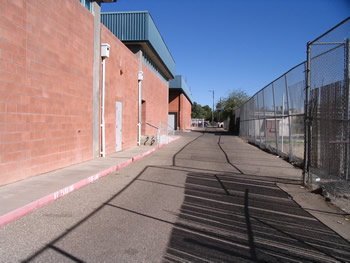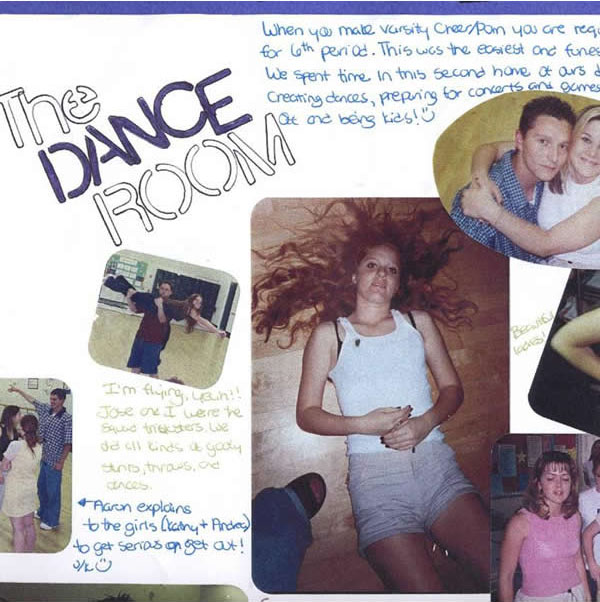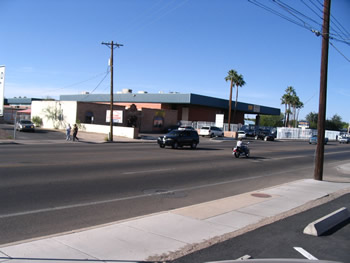Spatial Shock:
Place, Space, and the Politics of Representation
| Visual Experiment | Space and Place | Spatial Shock | Strolling | Contested Conclusion(s) | References |
Space and Place
Representations of Place
By showing stagnant (if alternating) images of the front of Catalina Foothills High School and Sunnyside High School, I hoped to inspire viewers to assume things about each school—perhaps even creating a moment of spatial shock for those unfamiliar with such school design. Knowing that a school is a specific kind of place, a place that is supposed to function in a certain way, viewers may see the buildings, landscaping, parking lots, and fences as conducive to and/or limiting of student learning, instructors teaching, or administrators supervising (or whatever the viewer assumes the function of school is). In my installation, I further shaped viewer reactions to each image by adding statistics about each school. Here are some examples:
- Sunnyside area’s median household income: $27,369 (compared to the AZ state average of $40,312).
- Sunnyside’s student demographics: 92% Hispanic, 3% Native American, 3% White, and 1% Asian American.
- Sunnyside’s 4-year senior graduation rate: 78%.
- Catalina Foothills area’s median household income: $63,756 (compared to the AZ state average of $40,312).
- Catalina Foothills’ student demographics: 75.4% White, 12.5% Hispanic. 9.6 % Asian, and 2.1% African American.
- Catalina Foothills’ 4-year senior graduate rate: 93% (Arizona Department of Education, 2008; Public School Review, 2011).
In this way, statistics and photography shape what outsiders think about each place and the people who inhabit these spaces, without even visiting the physical school. Such representations authorize me (the service-learning coordinator and scholar of rhetoric) and viewers (writing instructors attending a university event or distant scholars reading an academic journal) to speak about each place as if we know it. We know that there is an inequitable graduation rate, perhaps stemming from the economic constraints of each school—somewhat evident in the visuals. There are also identifiable differences in the ethnicities and class status of students attending the schools, perhaps informing structural decisions such as enclosing the campus with a pointed, tall fence versus decorating the inter-campus entrance with a gate of ornate ironwork.
The connections between visuals and statistics lead to important insights about the power dynamics of a particular place, but also may lend to reductive assumptions about the people who go there and the daily interactions that create each space. Art historian Miriam Paeslack (2010) wrote, “a reproduced image can come to stand in for reality, erasing the consequences of space and time” (p. 63). In this case, the students become nothing more than the walking figure in a pedestrian signal—produced and boxed in by the hierarchal power relations and material conditions of the school.
Distinguishing Place from Space
Such reductive understandings of people in place is one of the reasons philosopher Michel De Certeau (1984) distinguished the term "space" from "place." In The Practice of Everyday Life, De Certeau explained that "a place is the order (of whatever kind) in accord with which elements are distributed in relationships of coexistence"; a place is thus "an instantaneous configuration of positions. It implies an indication of stability" (p. 117). When outsiders look at an unfamiliar building from afar, such as through a photograph of its exterior, they see a seemingly stable, concretely distinguishable “place.” As an example, my former high school, Flowing Wells, is a place. It is located in a specific region of northwest Tucson, Arizona. Flowing Wells is comprised of stable buildings made of durable materials. It is a campus ordered by buildings that hold classrooms, departments, and programs, each with their own organizational framework for staff, administration, and students. These diverse elements of the school are consciously ordered and designed to assist with the functioning of the education process in this place.
Contrary to place, De Certeau explained that a "space is composed of intersections of mobile elements" (p. 117). On any given day Flowing Wells is a space. It is composed of/by students learning (or sleeping, texting, giggling) in the classroom, security personnel driving around the grounds, teachers hurrying to staff meetings, and delivery trucks moving through the parking lot. Although the school is designed as a place for education, that is not always what occurs in the classroom or on the campus. Or sometimes, it is exactly what occurs. In this sense, "space is a practiced place" (p. 117).
De Certeau offered the example of people walking on the street. Pedestrians transform the street from a place that is "geometrically defined by urban planning" into a space that is useful or pleasurable for them (p. 117). While a specific street is a place with discernible material aspects (asphalt or dirt, sidewalks or no sidewalks, a straight path or a curvy one) that affect the kinds of activity that can occur on that street, these material aspects do not necessarily determine what will take place on it. For example, a pedestrian could walk on and off the pathway, turn right or left at another street, draw on the sidewalk with chalk, plant things in the dirt, protest or celebrate something.
Distinguishing between space and place in this way is certainly confusing, but also important when considering the relationship among space, power, and social relations. Edward W. Soja (1989), in his book Postmodern Geographies: The Reassertion of Space in Critical Social Theory, argued that "the organization, and meaning of space is a product of social translations, transformations, and experience" (p. 80). He coined the term spatiality to capture the dynamic nature of space. Just as De Certeau's (1984) definition of space distinguished it from a stable notion of place, Soja's (1989) definition of spatiality disentangles notions of naturalness from material conditions of place and suggests that spatiality is a dynamic that affects our life experiences. Indeed, Soja saw "an essential connection between spatiality and being" (p. 119). That is, schools do not naturally function as education, but instead, the relationships between students, teachers, administrators, landscapers, and the material elements of the place compose school as a space and student as a specific way of being—in a specific moment.
Trying to look at places as spaces opens up opportunities to see philosopher Michel Foucault’s (1997) point that power is relational. At no time and in no place are power relations stable. This instability leaves room for resistance. This point is especially important when considering space as dynamic, relational, and variable. Even though a space may be designed for a positive practice (as schools are designed for learning) or for repression (as prisons are designed for disciplining), the action is not determined by the construction of those places. They are, at any moment, spaces alive with the potential for social interpretation and use.
But, if spaces are temporally specific relations between specific subjects and their material environment, how do outsiders see and analyze this potential? In preparing my installation, and a tentative answer to this question, I returned to my high school to reflect on my experiences as a high school student in that place/space. Below, I include images and narratives of my place and space—Flowing Wells High School. In offering visuals and in performing self-conscious reflection I hope to capture this place as a space.
My Place and Space
My experience taking FYC students to local schools in Tucson has shown me that others (outsiders) could view this school as a particular kind of place, if they were to base their opinions on the design of the school. Situated in a low-income area of Tucson and surrounded by a tall blue fence, the school looks kind of like a prison. Quite honestly, as a student there, it did feel like a prison at times (but don't many high schools?). I remember hating the feeling of being watched all the time and the ways catty self-important officials at the school were always suspicious of what we students were doing. I recently returned to the campus on a Saturday with my daughter and took pictures that showcase it as a stable, determining place. Looking at these photos, one could come to conclusions about the concrete, asphalt, fences, barbed wire, dumpsters, and how they determine the actions that take place in that space. One may even be right in assuming that the design of the school worked to interpellate its students as obedient, submissive citizens rather than creative, independent-thinking subjects. However, if you read my stories and interpretations of these places you will see that they functioned quite differently as spaces.

Figure 1. Outside Flowing Wells High School
The large blue fence in Figure 1 is a trademark of Flowing Wells High School. Though the large metal bars curve outward to the street, we didn't even think about the fence protecting us. I always thought of it (and the security guards patrolling the school) as keeping us in. Thus, by my junior year I considered school, in a lot of ways, as a kind of game. They kept trying to keep us in, and we kept trying to get out. I see it as an experience that fostered my sense of rebellion. The scar on my knee (from scaling the fence on Valentine's Day) is proof.

Figure 2. An alley at the school, with doors leading in
Entering the school's dance room on any given day meant going through the alleyway created by the large brick wall and chain link fence. We knew we needed to get to class to begin stretching and exercising, and to avoid discipline from patrolling security officials. But, we also used the space in ways that were meaningful to us, often snapping pictures and playing with what our bodies could do. In scrapbooking this page as a teenager, I capture this aspect of the space (see Figure 3).

Figure 3. Scrapbook of the Dance Room at Flowing Wells

Figure 4. The Texaco across from Flowing Wells.
Parking at Flowing Wells cost $10 each academic year. I thought this was extortion (ha!), and I needed a place to smoke before class, so I would park across the street at the Texaco (see Figure 4). I would huddle in a circle with friends (or sometimes alone), smoking my Marlboro Reds, inhaling my bad-ass identity, and preparing for the high school experience. This was my view. This was an important space for me and negotiating my experience of high school.